![]()
![]()
![]()
Use LEFT and RIGHT arrow keys to navigate between flashcards;
Use UP and DOWN arrow keys to flip the card;
H to show hint;
A reads text to speech;
57 Cards in this Set
- Front
- Back
- 3rd side (hint)
|
What is the structure of alveoli (3 parts)?
And type of tissue? |
Septal Cells
Alveolar Macrophages Respiratory Membrane |
Simple Squamous Epithelium
|
|
|
Septal Cells?
|
Produce lipid called surfactant (reduces surface tension on alveoli)
|
Prevents them from collapsing
|
|
|
Alveolar Macrophages
|
Phagocytic cells that combat foreign materials (dust busters).
Part of Alveoli |
|
|
|
Respiratory Membrane
|
Simple Squamous tissue of alveoli and capillaries (2 layers)
Respiratory Gasses diffuse here |
|
|
|
Respiratory Distress Syndrome
|
Insufficient surfactant results in immature lungs in fetus. Leading cause of Fetal death. (respiratory distress syndrome)
|
|
|
|
Pleural Membrane
|
Visceral adheres to itself
Parietal adheres to thoracic cavity These 2 layers contact and keep lungs inflated They cover the lungs |
|
|
|
Lungs (Lobulated?)
of Man? |
All vertebrate lungs are lobulated
|
Man has 2 left lobes, 3 right lobes
|
|
|
Inhalation aka?
Active/Passive? What muscles? What happens to volume, pressure etc? |
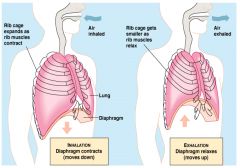
Inspiration
Active process Muscles between ribs called intercostal muscles and diaphragm must contract |
By contracting intercostal muscles and diaphragm, interthoracic volume and interpulmonary volume increase, thus pressure decreasing. Atmospheric pressure being greater than lung pressure results in inhalation.
|
|
|
Exhalation aka?
Active/Passive? |
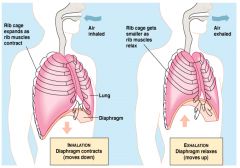
Expiration
Passive process Simply the recoil of contracted muscles |
|
|
|
Functional unit of Respiratory System?
|
Alveoli
|
|
|
|
At 100mmHg 98.5% of Oxygen is transported as what?
Oxygen binded to? |
Oxy-hemoglobin
Iron (Fe) component of hemoglobin can transport 4 Oxygen molecules |
Only 1% is dissolved oxygen
|
|
|
What are the 3 factors affecting % saturation aka?
Explain each Which is greatest and least contributor? |
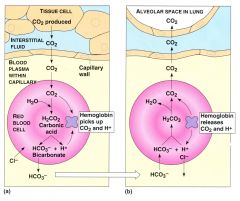
% Saturation = amount of oxyhemoglobin
Partial Pressure of Oxygen Bohr Effect Temperature |
Partial pressure of oxygen is greatest factor. Low = less % saturation (Graph)
Bohr Effect- hydrogen binds to hemoglobin altering its structure, causing release of oxygen from molecule (less % saturation). Decreasing pH (increasing acidity) does same thing. Hydrogen ions come from CO2. Higher temperature favors dissociation of oxygen, thus less % saturation |
|
|
3 Ways CO2 is transported?
Greatest and least contributor? Explain each |
CO2 dissolved in plasma (10%, least)
Carbaminohemoglobin (30%) Bicarbonate Ions (60%) (Chloride shift included) |
Carbaminohemoglobin -
When carbon dioxide binds to hemoglobin, carbaminohemoglobin is formed, lowering hemoglobin's affinity for oxygen via the Bohr effect. Bicarbonate Ions- Carbonic acid dissociates into bicarbonate resulting in bohr effect. (Chloride Shift)- -For every bicarb ion leaving blood cell (entering plasma) to be transported to lungs, a chloride ion enters cell to prevent ionic imbalance in cell. -At lungs the reverse happens |
|
|
3 Conditions effecting gas exchange through stomata + guard cells (causing turgidness)
and 3 causing flaccidness? |
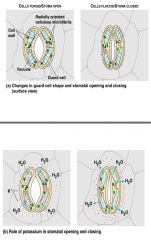
(Potassium moves into guard cells, water follows osmotically)(Turgid and open)
Light, Low CO2, Biological Clock |
(Potassium moves out of guard cells, water follows osmotically)
(Flaccid and closed) Dehydration, High CO2, Abscistic Acid (when plant stressed) |
|
|
3 Forces contributing to transpiration?
What part of plant performs and subunits? Explain the 3 forces |
Transpirational Pull
Root Pressure Cohesion theory of Water Water moves up plant through Xylem. Subunits: Tracheids and vessel elements function as dead empty channel up through root. |
Transpirational Pull
• Evaporation of water vapor through the stomata • Establish of water potential (dry at top of plant), water wants to move up to plant to replenish Root Pressure: • Osmotic pressure caused by solute concentration from soil into root Cohesion theory of Water: - Since water stays together through dipole attraction, once you push it through it will move through xylem and adhere to walls of xylem. - Most forceful of the 3 phenomena of water up through xylem |
|
|
2 Units of Phloem Tissue?
Describe them |
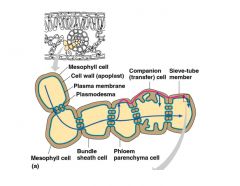
Sieve Cells/ Sieve Tube Members
Companion Cells/Albuminous Cells Alive at maturity (Active transport) |
Sieve elements are the group of cells that are responsible for actually moving sugar-laden fluids through the plant.
The survival of sieve-tube members depends on a close association with the companion cells, a specialized form of parenchyma cell. All of the cellular functions of a sieve-tube element are carried out by the (much smaller) companion cell |
|
|
3 Cell types of Xylem tissue?
|
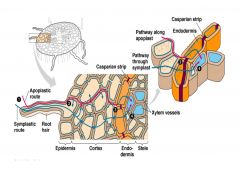
Tracheids and Vessel Elements
Living Parenchyma Fibers Dead at maturity (Passive transport) |
|
|
|
What is source and sink?
|
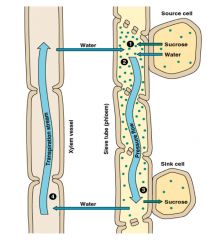
Source= location sugar is produced
|
Sink= where it is used
|
|
|
Loading part of translocation means what?
What pump does it use to perform this? |
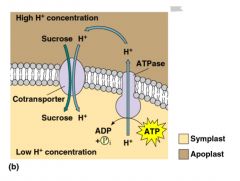
Active transport of sucrose into phloem against concentration gradient, sucrose (made in leaf)
|
Proton Pump
|
|
|
Unloading part of translocation occurs where?
How is water involved? |
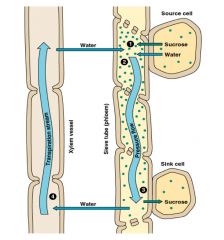
Unloads sugar at sink.
Active transport of out of phloem. Water osmotically follows |
|
|
|
3 levels of breathing and explanation?
|
External
Internal Cellular |
External - breathing in O2 and out CO2
Internal- Exchange of gases between blood and capillaries Cellular- utilization of nutrients and oxygen to produce energy |
|
|
What is tendinniae and where is it located?
|
Cutin spirals in epithelial wall of tracheal tubes that prevent collapse and is located in tracheal systems
They are not located in tracheoles, the smallest of the branches |
|
|
|
Describe tracheal systems and tracheoles?
|
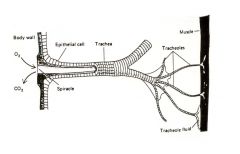
Found in insects and some other arthropods
Does not use circulatory system to transport respiratory gases Takes air directly from outside Branched network of tubes kept open by tennidiae Branches to all cells of body and gas exchange takes place to cells at smallest of tubes called tracheoles Made up of series of tubes |
Tracheoles are permeable to gas and liquid
|
|
|
What is an operculum?
|
Covers the gill region of fish
|
|
|
|
Type of tissue in upper respiratory system of man?
|
Pseudostratified Ciliated Columnar
|
|
|
|
Type of tissue in nasomucosa of man?
|
Pseudostratified Ciliated Columnar
|
|
|
|
Type of tissue in nasopharynx of man?
|
Pseudostratified Ciliated Columnar
|
|
|
|
Eustacian tubes connect middle ear to what?
|
Naso pharynx (lateral portion)
|
|
|
|
Type of tissue in oropharynx of man?
|
Stratified Moist Squamous
|
|
|
|
Type of tissue in mucous membrane of larynx in man?
|
Stratified Moist Squamous
|
|
|
|
3 unpaired larynx cartilages?
|

Epiglottis
Cricoid Thyroid |
|
|
|
Type of tissue in Tunica mucosa of trachea?
Function of trachea? |
pseudostratified
|
Transport of air only
|
|
|
Name of nitrogen preparing bacteria?
Has what kind of relationship with what kind of plant? |
Nitrogen fixing bacteria present in soil called Rhizobium.
Has symbiotic relationship with some legumes containing nitrogenase |
|
|
|
Symplast
|

Mineral enters root hair, enters cell (through membrane), can use plasmodesmata to go from cell to cell into the stele
|
|
|
|
Apoplast
|
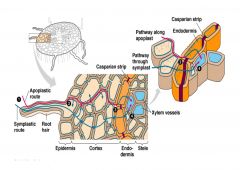
Enters space at cell wall & cell membrane, never enters a cell. When it gets to endodermis, it must go through casparian strip to get into stele
|
|
|
|
What is Thyroid cartilage?
What is attached to inside |
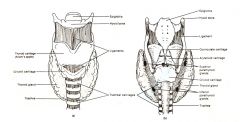
Single flat cartilage
Adam's Apple |
Attached to inside is epiglottis
|
|
|
What is function of epiglottis?
|
Flap that closes over entrance to larynx when eating
|
|
|
|
What is glotis
|
Slit-like entrance to larynx
|
|
|
|
Function of Vibrissae?
|
Course hairs at entrance to external nare that filter air
|
|
|
|
Function of Conchae?
|
Warms air
|
|
|
|
3 factors effecting absorption of material in roots?
|
• Concentration of material inside and outside plant
• How easily a mineral can pass through membranes or ion channels in membrane • The extent to which carriers are available |
|
|
|
What are the 3 components of soil?
|
Inorganic matter (Mineral)
Organic Matter Pore Spaces |
|
|
|
What is humus?
|
partially decayed organic matter
|
|
|
|
3 layers of wall of heart?
|
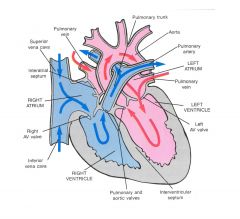
Epicardium (outer)= inner layer of serous membrane (pericardium)
Myocardium (middle)= cardiac muscle Endocardium(inner) = endothelium |
|
|
|
3 layers of wall of vessels and description?
|
• Tunica intima
- closest to lumen - made of simple squamous epithelium (lining blood vessels is called endothelium) • Tunica media - Forms bulk of wall of vessel - Thickest layer - Smooth muscle - Responsible for vasodilation and vasoconstriction of vessel • Tunica adventitia - Outer connective tissue layer - Anchors vessels to other tissues and nerves to blood vessels. - In large arteries like aorta, wall of vessel has vessels within called vasa vasorum (means “vessels of vessels) |
|
|
|
Smallest arteries called?
|
Arterioles
|
|
|
|
3 events of Hemostasis?
|
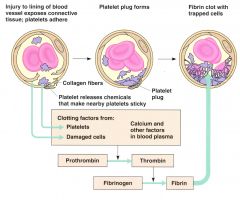
Blood Vessel Spasm
Platelet Plug Formation Formation of Clot- most effective |
|
|
|
Functions of circulatory system?
|
o Transport
o Regulation of body temperature o Maintain fluid balance o Contains most cells for body’s defense system |
|
|
|
Where does the production of sound come from?
|
Vocal folds in the larynx
|
|
|
|
What are the 3 paired larynx cartilages?
|
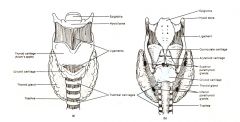
artenoids, corniculates, cuneiforms
|
|
|
|
Vessel Elements Diagram
|
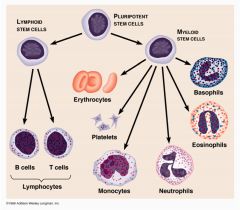
|
|
|
|
Conduction System Diagram
|
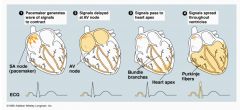
|
|
|
|
Heart Diagram
|
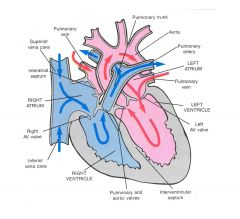
|
|
|
|
Gas Exchange at capillaries diagram
|
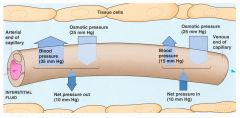
|
|
|
|
Hemoglobin Saturation % vs Pressure O2 Chart
|
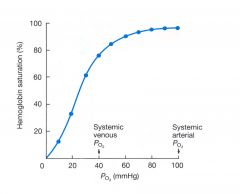
|
|
|
|
another O2 Saturation % vs Pressure O2 Chart
|

|
|
|
|
Temperature effect on % saturation vs O2 Chart
|

|
|

